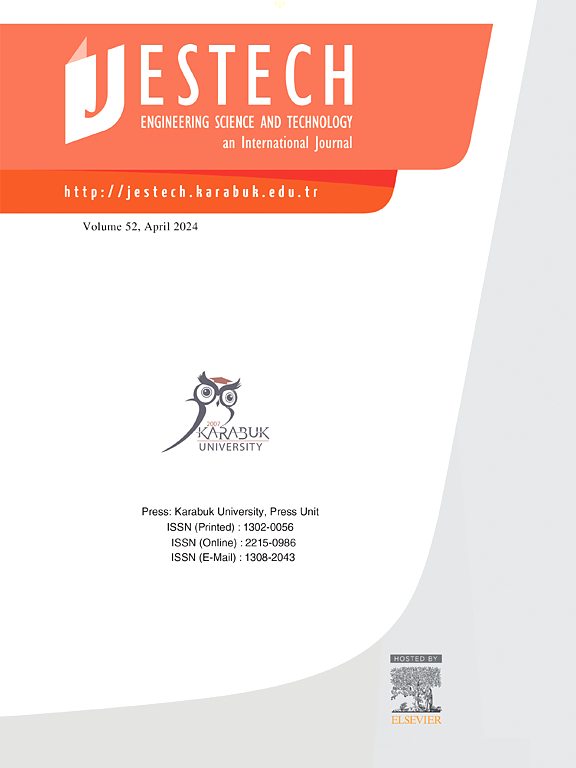电磁感应作用下生物神经元模型的复杂潜伏期动力学
IF 5.1
2区 工程技术
Q1 ENGINEERING, MULTIDISCIPLINARY
Engineering Science and Technology-An International Journal-Jestech
Pub Date : 2025-04-08
DOI:10.1016/j.jestch.2025.102038
引用次数: 0
摘要
在这项研究中,电磁感应对霍奇金-赫胥黎(H-H)神经元的脉冲潜伏期动力学的影响进行了研究。研究表明,第一个峰值的时间是一种有效的信息载体,与随后的峰值相比,第一个峰值的延迟包含更多的神经元信息。在随机扰动的作用下,第一峰延迟会显著增加,这被称为噪声延迟衰减(NDD)现象。另一方面,由于微观层面的生物物理活动,特别是离子在细胞膜上的运输,会引起一个暂时的、不断变化的电磁场,从而形成对该神经元的反馈贡献。在这里,我们的目的是了解这种电磁场产生的感应电流对单个随机霍奇金-赫胥黎模型神经元的第一尖峰时序行为的影响。为了实现这一目标,我们展示了随机神经元在不同信号频率下根据信道噪声强度的脉冲延迟的动态行为。我们发现NDD行为明显出现在临界超阈值频率。我们的研究结果还表明,电磁感应可以减少第一次脉冲延迟,并且暴露在相对较高的电磁场中的神经元更容易发出合理的快速放电。这意味着电磁感应可以调节脉冲延迟的功能作用,并消除NDD的不良影响。本文章由计算机程序翻译,如有差异,请以英文原文为准。
Complex latency dynamics of biological neuron model under effect of electromagnetic induction
In this study, the effect of electromagnetic induction on spike latency dynamics in the Hodgkin–Huxley (H–H) neuron is investigated. It has been shown that the timing of first spikes is an effective information carrier and delay in the first spike contains more neuronal information compared to subsequent spikes. The first spike latency can increase significantly by stochastic perturbations, and this is known as noise delayed decay (NDD) phenomenon. On the other hand, due to micro level biophysical activities, particularly transport of ions across the cell membrane causes a temporary and changing electromagnetic field, which forms a feedback contribution to that neuron. Here, we aim to understand the effects of induction current produced by such electromagnetic field on the first spike timing behavior in a single stochastic Hodgkin–Huxley model neuron. To achieve this aim, we demonstrate the dynamic behavior of stochastic neuron regarding spike latency depending on channel noise intensity at varying signal frequency. We show that NDD behavior apparently emerges at critical suprathreshold frequencies. Our results have also shown that electromagnetic induction can decrease the first spike latency and that it becomes easier for the neuron exposed to relatively higher electromagnetic fields to emit reasonably rapid firings. This implies that electromagnetic induction can regulate the functional role of spike latency and remove undesired impacts of NDD.
求助全文
通过发布文献求助,成功后即可免费获取论文全文。
去求助
来源期刊

Engineering Science and Technology-An International Journal-Jestech
Materials Science-Electronic, Optical and Magnetic Materials
CiteScore
11.20
自引率
3.50%
发文量
153
审稿时长
22 days
期刊介绍:
Engineering Science and Technology, an International Journal (JESTECH) (formerly Technology), a peer-reviewed quarterly engineering journal, publishes both theoretical and experimental high quality papers of permanent interest, not previously published in journals, in the field of engineering and applied science which aims to promote the theory and practice of technology and engineering. In addition to peer-reviewed original research papers, the Editorial Board welcomes original research reports, state-of-the-art reviews and communications in the broadly defined field of engineering science and technology.
The scope of JESTECH includes a wide spectrum of subjects including:
-Electrical/Electronics and Computer Engineering (Biomedical Engineering and Instrumentation; Coding, Cryptography, and Information Protection; Communications, Networks, Mobile Computing and Distributed Systems; Compilers and Operating Systems; Computer Architecture, Parallel Processing, and Dependability; Computer Vision and Robotics; Control Theory; Electromagnetic Waves, Microwave Techniques and Antennas; Embedded Systems; Integrated Circuits, VLSI Design, Testing, and CAD; Microelectromechanical Systems; Microelectronics, and Electronic Devices and Circuits; Power, Energy and Energy Conversion Systems; Signal, Image, and Speech Processing)
-Mechanical and Civil Engineering (Automotive Technologies; Biomechanics; Construction Materials; Design and Manufacturing; Dynamics and Control; Energy Generation, Utilization, Conversion, and Storage; Fluid Mechanics and Hydraulics; Heat and Mass Transfer; Micro-Nano Sciences; Renewable and Sustainable Energy Technologies; Robotics and Mechatronics; Solid Mechanics and Structure; Thermal Sciences)
-Metallurgical and Materials Engineering (Advanced Materials Science; Biomaterials; Ceramic and Inorgnanic Materials; Electronic-Magnetic Materials; Energy and Environment; Materials Characterizastion; Metallurgy; Polymers and Nanocomposites)
 求助内容:
求助内容: 应助结果提醒方式:
应助结果提醒方式:


